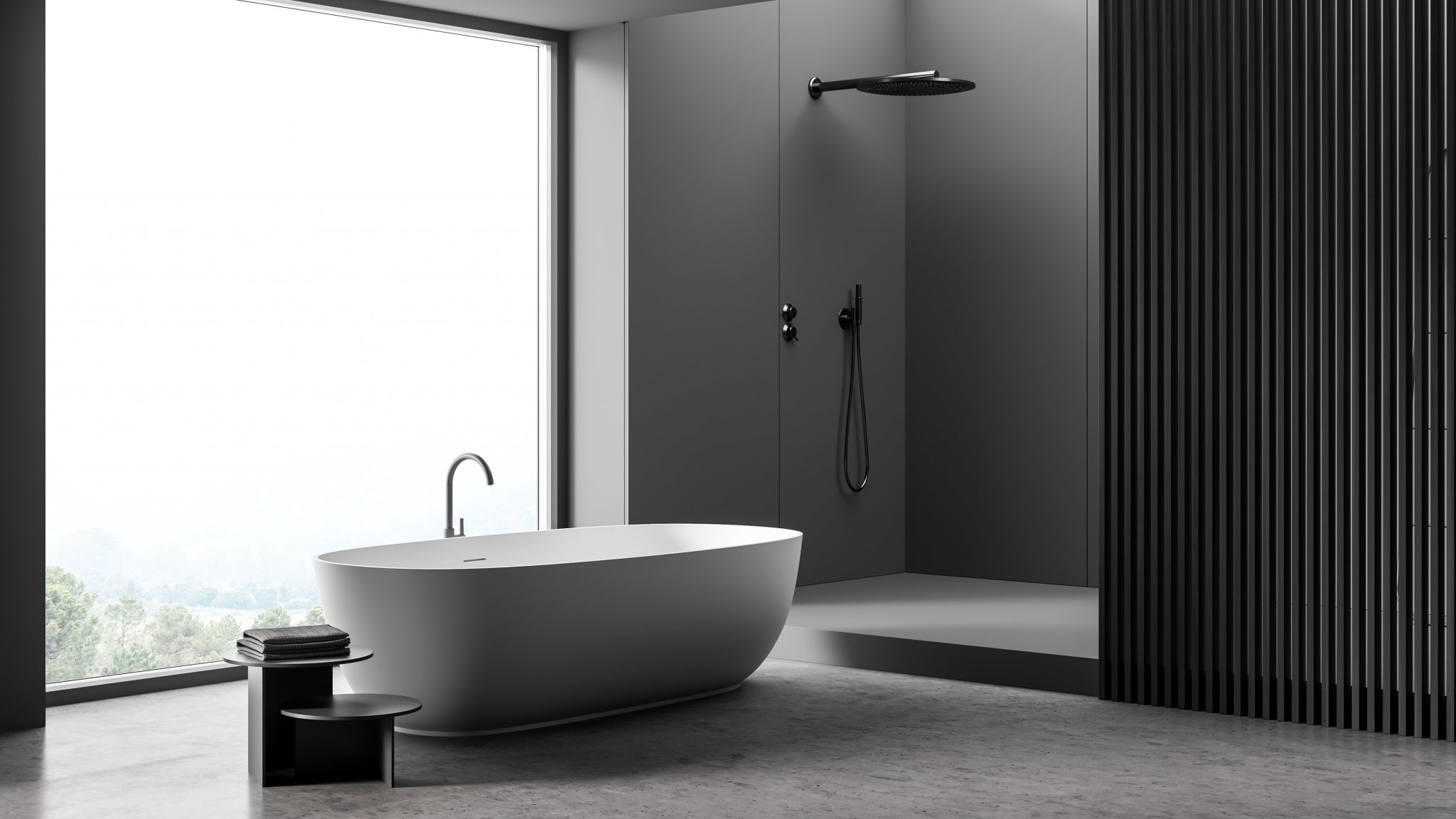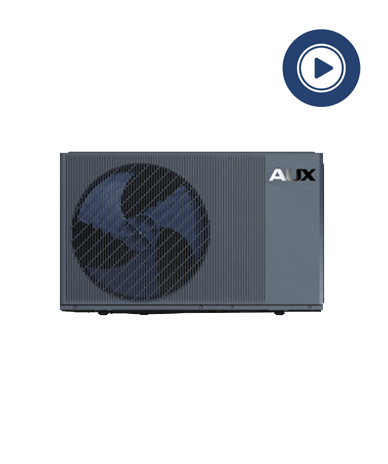R290 Monoblock Heat Pump
Highest COP : 5.06

Air to Water Heat Pumps
High efficiency domestic space and water heating systems


SEER/ SCOP Range: 8.2/5.4 (A+++)
Temperature Operating Range: -25 – 52°C
Compressor: DC Inverter
Heating and Cooling Operation
Wifi Control
Hot Water Tank: 80°C
Space heating water temp (Max): 85°C
Capacity Range: 4-16kw
R290 Monobloc Air Source heat pump unit is an integrated air to water system which can supply space heating, cooling and domestic hot water. The monobloc heat pump system extracts heat from the outdoor air and transfers this heat through refrigerant piping to the plate heat exchanger in the monobloc unit. The heated water in the monobloc unit circulates to the heat emitters (underfloor heating loops or low temperature radiators) to provide heating, and to the domestic hot water tank to provide domestic hot water.
Air to Water Heat Pumps Features
Dual Temperature Control
The AUX Air To Water Heat Pump can deliver high water temperature to radiators whilst at the same time delivering lower temperature water to your floor heating, meaning that conditions can be optimal throughout the house at all times.
High Quality DC Compresso
The Halo model uses a quality DC Inverter Compressor guaranteeing the highest performance and reliability standards.
Ultra Efficient Space Heating Solution
Hot water heated up to 65°C is available for floor heating and low temperature radiators. Both heating and cooling can operate using the heat pump.
Hot Water Fast
The System includes the Fast Hot Water Function, which when selected the heat pump and hot water tank are electrically heated at the same time, giving you instant Hot Water, up to 60°C.
Solar Connection
For even greater savings, solar collectors can be connected to deliver about 60% of a household’s hot water energy needs throughout the year.
Wifi Connectivity
The water module control board is WIFI ready, allowing the heat pump to contol di”erent parameters from your smartphone. These parameters include: switch system on and o”, Temperature settings and enabling various functions that are included in the system.
Heat Pumps .
Heat pumps operate on the fundamental principle of transferring heat from one location to another, rather than generating it directly. While various types of heat pumps exist, they all share a common operational cycle: absorption, boosting, transfer, and repetition. The primary distinction lies in the source from which they extract heat.
Types of Heat Pumps
- Air Source Heat Pumps: These are the most prevalent type, extracting heat from the ambient air. They are widely favored due to their ease of installation and cost-effectiveness.
- Water Source Heat Pumps: These systems utilize nearby water bodies like lakes, rivers, or wells as their heat source. Although more complex to install, they offer exceptional efficiency.
- Ground Source Heat Pumps: These pumps harness the Earth’s natural geothermal heat. They provide consistent performance but require more extensive installation procedures due to ground excavation.
Operational Cycle
Regardless of the heat source, all heat pumps follow the same basic steps:
- Absorption: The heat pump absorbs heat from the source, whether it’s air, water, or ground.
- Boosting: The absorbed heat is amplified using a refrigerant cycle, increasing its temperature.
- Transfer: The boosted heat is transferred to the desired location, typically inside a building.
- Repetition: The cycle continuously repeats to maintain the desired temperature.
Operating Principle
ASHPs extract heat from the ambient outdoor air, even in cold temperatures, and transfer it indoors to provide heating and hot water. This process involves:
- Heat Extraction: The heat pump’s outdoor unit draws in air and absorbs the available heat energy.
- Heat Amplification: A refrigerant cycle increases the temperature of the absorbed heat.
- Heat Transfer: The amplified heat is transferred to the home’s heating system, such as radiators or underfloor heating, and to a hot water cylinder for domestic use.
Benefits of ASHPs
- Low-Carbon Heating: ASHPs significantly reduce carbon emissions compared to traditional fossil fuel boilers, contributing to a smaller environmental footprint.
- Dual Functionality: They provide both space heating and hot water, eliminating the need for separate systems. * Year-Round Operation: Modern ASHPs are designed to operate efficiently even in cold climates, with some models capable of functioning in temperatures as low as -25°C.
Addressing Common Concerns
- Heating Efficiency in Cold Weather: While ASHPs extract heat from cold air, they may require larger radiators or underfloor heating to optimize heat distribution. A comprehensive technical survey and heat loss calculation can ensure optimal system sizing and performance.
- Hot Water Provision: ASHPs effectively heat water for domestic use, typically storing it in a hot water cylinder for on-demand availability.
ASHPs offer a sustainable and efficient solution for home heating and hot water. By understanding their operating principles and addressing common concerns, homeowners can make informed decisions about incorporating this technology into their homes.
Financial Incentives for Air Source Heat Pump Installation
Various grants and schemes are available to support homeowners in transitioning to air source heat pumps. These incentives can significantly reduce the upfront costs associated with installation, making it a more affordable investment. Our team can provide guidance on applicable programs and assist with the eligibility determination process.
Streamlined Installation Process
Our commitment to customer satisfaction extends to a hassle-free installation process, ensuring a smooth transition to your new heating system. Here’s an overview of what you can expect:
- Comprehensive Assessment: A thorough evaluation of your home’s heating requirements and energy efficiency needs is conducted to determine the optimal heat pump system configuration.
- Tailored System Design: A customized system is designed to meet your specific needs, ensuring optimal performance and energy efficiency.
- Professional Installation: Our team of skilled technicians will expertly install your heat pump system, adhering to the highest quality standards.
- >Rigorous Testing: Comprehensive testing is performed to verify the system’s functionality and ensure it operates at peak performance.
- Thorough Handover: We provide detailed guidance on operating your new heat pump system, addressing any questions or concerns you may have.
Our goal is to make the transition to an air source heat pump as seamless and stress-free as possible, providing comprehensive support throughout the entire process.
Our goal is to make the transition to an air source heat pump as seamless and stress-free as possible, providing comprehensive support throughout the entire process.